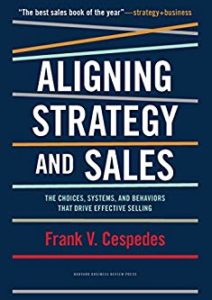Interview with Frank Cespedes, Part 2
Frank Cespedes teaches at Harvard Business School, and is the author of Aligning Strategy and Sales: The Choices, Systems, and Behaviors that Drive Effective Selling (Harvard Business Review Press), which was cited as “the best sales book of the year” (Strategy + Business), “a must read” (Gartner Group), and “perhaps the best sales book ever” (Forbes).
This is part 2 of a 2 part interview with Frank on the crucial subject of aligning sales efforts with company strategy.
3. How can sales metrics be better aligned to forward company strategy?
The most important thing about selling is the buyer, not the seller. So start by understanding the buying journey at target customers and the implications for key activities in the sales funnel. Every company is different but every business has a funnel. Some are relatively short and simple, while others are long and complex. This makes a big difference in clarifying key metrics. Here’s an example from case studies that I teach in my MBA and executive-education courses.
Consider two SaaS companies. One sells a menu-display and advertising platform to restaurants—a big but fragmented market where buyers’ budgeting processes make it important for the seller to be there at the right time to close a sale. Once sold, however, this firm has low marginal costs in setting-up and maintaining a customer on its platform. In this situation, “feed the funnel” by measuring and monitoring top-of-funnel metrics like lead generation, call frequency, and so on, as well as closed deals.
By contrast, another firm sells subscription software that provides big productivity and ecological benefits IF the customer is willing to alter traditional work-flow processes and use the software at sufficient scale. This is a buying and selling process where ongoing customer education and lengthy onboarding is crucial. Initial enthusiasm from a prospect’s IT or “green” community can be deceptive and expensive. Here, lead generation is less important than pursuing the right leads. Further, this firm’s profit margins are primarily in contract renewals and other services it can sell IF it gets the right scale and usage in the initial sale. Here, metrics should encourage reps to vet the top part of the funnel carefully so they don’t spend months chasing the wrong prospects, while management provides reps with the means and incentives to manage the lengthy sale and renewal process for the right prospects.
Also, remember that markets don’t care about any specific firm’s strategy and sales process. Markets will do what they do for lots of reasons that are outside the seller’s control: technology, competition, regulations, macroeconomic conditions, and so on. The seller must adapt to the market, not the other way ‘round. Performance metrics should change as the market changes so that, in their reviews, managers are monitoring the activities that are relevant for today, not yesterday.
4. A common issue is promoting salespeople to sales managers. Say a bit about this transition.
Frontline sales managers hire reps and influence their development; they allocate sales resources and incentives across market opportunities; they conduct (we hope!) performance reviews, and so reinforce good or bad behaviors. And when other functions need something from Sales, it’s sales managers they contact. In most companies, sales managers are how core levers for aligning strategy and sales are executed, or not.
This crucial role gets mixed reviews. Nearly every firm has examples of successful salespeople who are disasters as managers because they persist in their behaviors as reps rather than managers. Also, studies indicate that, in the short term, excellent reps with an average manager outsell average salespeople with an excellent manager. As they say in baseball, it’s the players, not the manager, who swing the bats. But over time, people working for an average manager tend to decline in performance. Why? Many of the best reps eventually get promoted, retire, or otherwise leave, exposing the underlying managerial talent. And an excellent salesperson is excellent within his or her territory or account, while a manager has, for good or ill, more influence across multiple areas and customers.
I have a few core pieces of advice for individuals and companies. First, the individual must understand that sales manager is not just a bigger sales job. It’s a fundamentally different set of responsibilities and skills. You move from individual contributor to someone who must now get things done with and through others. This transition is not unique to sales. But it’s especially wide there because many reps are solo flyers who, to free-up more time for selling, often actively dissociate themselves from “the administrative stuff” during their time as reps. The move to manager is then a very surprising role reversal.
Second, most managerial learning is learning-from-experience. But it’s no coincidence that on-the-job learning is called “the school of hard knocks.” Companies can help accelerate that learning by a) explicitly acknowledging the need to do this; b) investing in relevant management development, not only sales training, for sales managers; and c) choosing carefully on whom to spend that time and money.
That last point means having candid career discussions with new or aspiring managers. Many sales organizations don’t do this. Some managers avoid these discussions because they want to keep good sales performers in their unit and not “lose” them. The company must make it clear that managers don’t “own” the available talent; they’re just renting it for some time. Others lack any framework for discussing careers in a meaningful way, falling back on slogans and platitudes about “leadership abilities” or “seasoning” rather than practical support or discouragement.
Sales managers require personal credibility because their job involves hiring, firing, and evaluating people. In part, you get that credibility by having “been there and done that” as a successful salesperson. So there’s nothing wrong, and a lot that’s right, with choosing sales people as sales managers. It reflects reality. But it’s how you choose and what happens before and after the choice that determines effectiveness. And that is a joint responsibility of the individual and the organization.













Comments